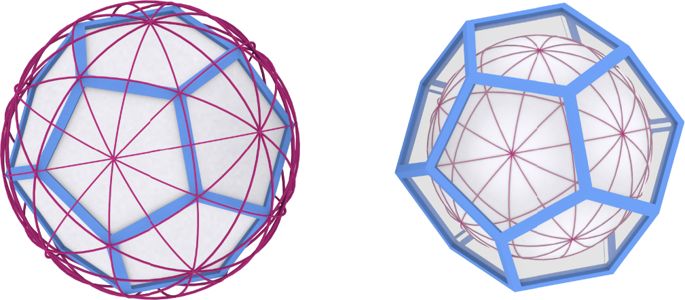Our official English website, www.x-mol.net, welcomes your
feedback! (Note: you will need to create a separate account there.)
Self-assembly of highly symmetrical, ultrasmall inorganic cages directed by surfactant micelles
Nature ( IF 50.5 ) Pub Date : 2018-06-01 , DOI: 10.1038/s41586-018-0221-0 Kai Ma 1 , Yunye Gong 2 , Tangi Aubert 1, 3 , Melik Z Turker 1 , Teresa Kao 1 , Peter C Doerschuk 2, 4 , Ulrich Wiesner 1
Nature ( IF 50.5 ) Pub Date : 2018-06-01 , DOI: 10.1038/s41586-018-0221-0 Kai Ma 1 , Yunye Gong 2 , Tangi Aubert 1, 3 , Melik Z Turker 1 , Teresa Kao 1 , Peter C Doerschuk 2, 4 , Ulrich Wiesner 1
Affiliation

|
Nanometre-sized objects with highly symmetrical, cage-like polyhedral shapes, often with icosahedral symmetry, have recently been assembled from DNA1–3, RNA4 or proteins5,6 for applications in biology and medicine. These achievements relied on advances in the development of programmable self-assembling biological materials7–10, and on rapidly developing techniques for generating three-dimensional (3D) reconstructions from cryo-electron microscopy images of single particles, which provide high-resolution structural characterization of biological complexes11–13. Such single-particle 3D reconstruction approaches have not yet been successfully applied to the identification of synthetic inorganic nanomaterials with highly symmetrical cage-like shapes. Here, however, using a combination of cryo-electron microscopy and single-particle 3D reconstruction, we suggest the existence of isolated ultrasmall (less than 10 nm) silica cages (‘silicages’) with dodecahedral structure. We propose that such highly symmetrical, self-assembled cages form through the arrangement of primary silica clusters in aqueous solutions on the surface of oppositely charged surfactant micelles. This discovery paves the way for nanoscale cages made from silica and other inorganic materials to be used as building blocks for a wide range of advanced functional-materials applications.Machine-learning algorithms are used to generate single-particle three-dimensional reconstructions, revealing that highly symmetrical dodecahedral silica cages, around 10 nm in size, self-assemble in the presence of surfactant micelles.
中文翻译:

由表面活性剂胶束引导的高度对称的超小型无机笼的自组装
纳米尺寸的物体具有高度对称的笼状多面体形状,通常具有二十面体对称性,最近由 DNA1-3、RNA4 或蛋白质 5,6 组装而成,用于生物学和医学。这些成就依赖于可编程自组装生物材料 7-10 的开发进展,以及从单个粒子的低温电子显微镜图像生成三维 (3D) 重建的快速发展技术,这些技术提供了高分辨率的结构表征生物复合物11-13。这种单粒子 3D 重建方法尚未成功应用于识别具有高度对称笼状形状的合成无机纳米材料。然而,在这里,结合使用低温电子显微镜和单粒子 3D 重建,我们建议存在具有十二面体结构的孤立的超小(小于 10 nm)二氧化硅笼('silicages')。我们提出这种高度对称的自组装笼是通过在带相反电荷的表面活性剂胶束表面上的水溶液中排列初级二氧化硅簇而形成的。这一发现为由二氧化硅和其他无机材料制成的纳米笼用作各种先进功能材料应用的构建块铺平了道路。机器学习算法用于生成单粒子三维重建,揭示了高度对称的十二面体二氧化硅笼,大小约为 10 nm,在表面活性剂胶束的存在下自组装。
更新日期:2018-06-01
中文翻译:

由表面活性剂胶束引导的高度对称的超小型无机笼的自组装
纳米尺寸的物体具有高度对称的笼状多面体形状,通常具有二十面体对称性,最近由 DNA1-3、RNA4 或蛋白质 5,6 组装而成,用于生物学和医学。这些成就依赖于可编程自组装生物材料 7-10 的开发进展,以及从单个粒子的低温电子显微镜图像生成三维 (3D) 重建的快速发展技术,这些技术提供了高分辨率的结构表征生物复合物11-13。这种单粒子 3D 重建方法尚未成功应用于识别具有高度对称笼状形状的合成无机纳米材料。然而,在这里,结合使用低温电子显微镜和单粒子 3D 重建,我们建议存在具有十二面体结构的孤立的超小(小于 10 nm)二氧化硅笼('silicages')。我们提出这种高度对称的自组装笼是通过在带相反电荷的表面活性剂胶束表面上的水溶液中排列初级二氧化硅簇而形成的。这一发现为由二氧化硅和其他无机材料制成的纳米笼用作各种先进功能材料应用的构建块铺平了道路。机器学习算法用于生成单粒子三维重建,揭示了高度对称的十二面体二氧化硅笼,大小约为 10 nm,在表面活性剂胶束的存在下自组装。











































 京公网安备 11010802027423号
京公网安备 11010802027423号